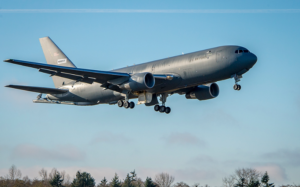The Air Force and Boeing [BA] have agreed on a set of performance parameters for a new remote vision system for the KC-46 Pegasus refueling aircraft and plan to conduct model tests over the next month ahead of approving the design, the service’s senior acquisition official said Sept. 4.
The remote vision system (RVS) is one of three outstanding Category 1 deficiencies on the KC-46 program, although the company began delivering aircraft this past January (Defense Daily, Jan. 25). The service has completed its first round of discussions with Boeing on the RVS fix, said Will Roper, assistant Air Force secretary for acquisition, in a media gaggle at the Defense News conference in Arlington, Virginia.

“When we accepted the airplane, …. we were able to shift the remote vision system from being a discussion over pictures to a discussion around nine performance parameters that are firm numbers,” Roper said. The service will take the next month to six weeks to conduct “hard research” on the proposed design, he added.
“Then we’re going to measure those performance parameters and if they meet them, great. And if not, then we’re going to have to keep working the design until they do,” Roper continued.
The original RVS had the issue of “stretching” the visual that operators see inside the aircraft, distorting their view of what is happening outside.
“It does this stretching and contracting of what the operator is seeing, that varies across the field of view like a rubber sheet,” Roper said. He declined to share what the new design involves, saying it is premature before the service and Boeing perform their analysis. But he was confident that establishing the performance parameters will help craft a design that allows the warfighter to perform the mission, without any “ocular discomfort.” The goal is to deliver a solution “as fast as we can,” he added.
The Air Force is also moving forward with a fix for the Category 1 deficiency involving the boom, Roper said. The service is on contract with Boeing to replace the actuator to allow the KC-46 to refuel A-10 attack aircraft, and is hoping to field a solution within the next two years (Defense Daily, June 21).
The fix should be a simple change to the Boeing production line aircraft, but it may be tricky to replace on KC-46 aircraft that have already been delivered, he noted. As of Aug. 30, Boeing has delivered 19 jets to the Air Force.
“The big issue is how do you want to do the cut-in for the things that are already fielded,” Roper said. “The fastest way for me to do it is not the best way for the warfighter.”
The Air Force has agreed to pay for the fix to the boom, as the original requirement did not work for the KC-46 to refuel the A-10. Boeing is funding the RVS improvement.